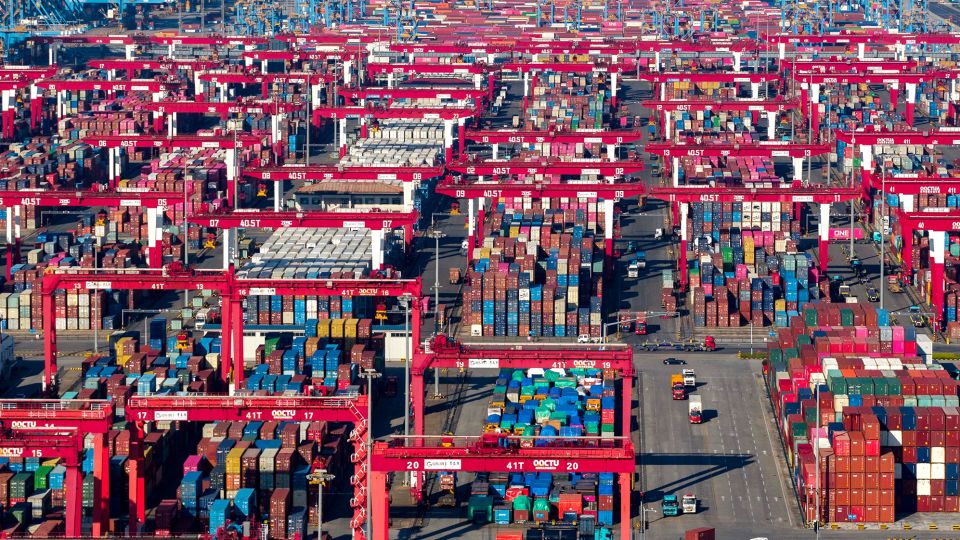Containers pile up at Qingdao Port Qianwan Container Terminal in Shandong Province, China, on September 25, 2025. – Costfoto/NurPhoto/Getty Images
Over the past few months, inflation has stayed relatively tame and economic sentiment among US businesses and consumers has improved, compared to earlier this year. A big reason for both: Tariffs on Chinese goods shipped to the United States fell dramatically in May and haven’t budged since.
That might not be the case for much longer. On Friday, President Donald Trump said his administration is calculating a “massive” tariff increase on Chinese exports to the United States.
His threat is tied to Beijing ramping up export controls on its critical rare earths, which are needed to produce many electronics. As a result, Trump appeared to call off a meeting with Chinese President Xi Jinping that was scheduled for later this month in South Korea.
Trump’s message, delivered via a Truth Social post, was ill received by investors on Friday as fears of a spring déjà vu, when tariffs on Chinese goods soared to a stunning 145%, set in. Markets slid on Friday following Trump’s post, with the Dow falling by almost 700 points, or 1.4%. The S&P 500 was down 2%, and the tech-heavy Nasdaq tumbled 2.7%.
While Trump doesn’t always act on his threats, investors, consumers and businesses still have reason to worry.
President Donald Trump is threatening to raise tariffs on Chinese goods shipped to the United States. – Jessica Koscielniak/Reuters
The United States and China are the world’s two largest economies. Although Mexico has recently replaced China as the top source of foreign goods shipped to the United States, America depends on China for hundreds of billions of dollars’ worth of goods. Meanwhile, China is one of the top export markets for America.
In particular, electronics, apparel and furniture are among the top goods the United States receives from China. Trump has pushed CEOs, especially in tech, to move production to the United States, but he’s softened his approach in recent months as business leaders have satisfied the president with announcements of hundreds of billions of dollars in investments in US manufacturing — even if they continue to make the bulk of their products overseas.
Shortly after imposing minimum 145% tariffs on Chinese goods — an effective embargo on trade, Trump issued an exemption for electronics, making them subject to 20% tariffs instead. The move was, in many ways, an acknowledgment that the Trump administration understood the pain he was inflicting on the US economy through his sky-high tariffs.
Then, in May, US and Chinese officials further established the interdependence of trade by agreeing to lower tariffs on one another. China brought levies on American exports down to 10% from 125%, and the United States brought rates down to 30% from 145%.
Both countries’ stock markets have since rallied as a result.
Trump on Friday claimed trade hostility from China “came out of nowhere.” But in reality, it’s been bubbling up for months.
For the United States, a critical part of trade agreements has been to ensure China will increase its supply of rare earth magnets. Yet despite several apparent breakthroughs, Trump has in recent months repeatedly accused China of violating the terms.
Trump first responded by putting restrictions on sales of American technologies to China, including a key Nvidia AI chip. Many of these restrictions were later lifted.
Then came the Trump administration’s announcement that it would soon impose fees on goods transported on Chinese-owned or -operated ships. China countered with a similar plan on American ships that took effect Friday.
In short: Trump has already demonstrated there’s no limit to how high he’ll go with tariffs on China, and Xi has shown no mercy in how he chooses to retaliate.
But Trump’s ability to continue to impose tariffs on a whim could soon end, pending the verdict in a landmark case kicking off in the Supreme Court next month. Xi, however, faces no such constraints.
For more CNN news and newsletters create an account at CNN.com

